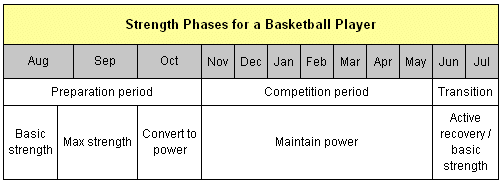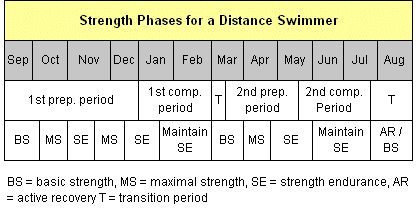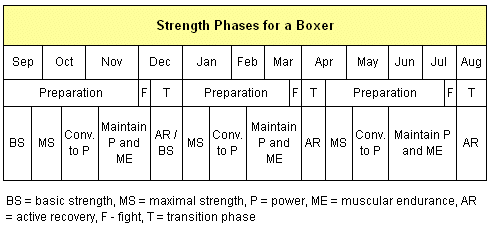Sport-specific strength training programs are fundamental to an athlete’s development and success. Long gone are the days when coaches shunned weight lifting for fear that it might hinder the performance of fine skill and correct technique. It’s now accepted that high levels of strength are a prerequisite to superior speed, power, strength endurance and overall sporting performance.
Unfortunately, most strength training programs fall well short of what an athlete requires…
Bodybuilding and Olympic weightlifting programs still dominate many athletes’ training regimes. While these types of training have their place, strength training for sport consists of a more refined approach than simply lifting heavy weights as many times as possible.
This article outlines the concept and the benefits of a periodized strength training plan. This is the most effective approach to strength training for sport. Not only does it help in the prevention of over training, it gives the athlete the best chance of peaking physically at the right time.
Exercise Selection
The principle of specificity states that training should mirror the demands of the sport as closely as possible (1). This applies not only to way the body’s energy systems and neuromuscular system is taxed (through manipulation of intensity and rest intervals etc) but also to the movement patterns of each exercise.
Bodybuilders tend to isolate a muscle group and work it to exhaustion. Athletes on the other hand should train movements rather than muscles. A simple example is the vertical jump. The muscles involved in this action (calves, quadriceps, hamstrings, gluteals etc.) could be trained separately with exercise choices such as toe raises, leg extensions, leg curls, kickbacks and so on. A more appropriate exercise however is a barbell squat, which closely matches the movement pattern of the vertical jump. Taken a step further, jump squats are even more specific to jumping and it’s not surprising that they increase vertical jump performance to the greatest extent (4).

Athletes must divide their time and energy amongst various types of training – endurance, strength and power, speed and agility, tactical etc., and find the time to recover! By choosing only the most appropriate resistance exercises volume can be kept to a minimum saving energy for other types of training.
This has led many coaches to incorporate Olympic weight lifting into their strength training programs, almost without question. The rationale is that just a few Olympic lifts will build all-round strength and power. Whilst exercise such as power cleans can be beneficial to some athletes, for many there are more specific and more appropriate options (2).
Many of the sample strength training programs within this section of the website consist of relatively few exercises. This is deliberate and while it may seem unbalanced at first glance, it takes into account other training the athlete is expected to complete.
Different Types of Strength Training
Unlike bodybuilding, where the only aim is to increase the size and appearance of muscles, strength training programs for sport ultimately must develop either explosive power or muscular endurance (2). However, rather than immediately embarking on a program to improve either or both of these fitness components, a more effective approach is to first build a solid foundation…
Basic Strength
Basic strength training programs adapt the body for more strenuous resistance training later on. It’s objective is to prepare the body by targeting all of the major muscle groups, tendons, ligaments and joints helping to prevent injury (2).
The less experienced an athlete is, the more time they will need to spend developing foundational strength before progressing onto more advanced forms of resistance training. But even experienced athletes should set aside some time during the year to complete a phase of basic strength training. It can help to redress some of the muscle imbalances that inherently occur with competitive sport.
Hypertrophy
Some athletes will benefit from increasing their lean body mass by adding extra muscle bulk. However, the number of athletes that require hypertrophy training or a phase of bodybuilding is far fewer than most would expect. Larger muscles are not necessarily stronger and more weight – even lean, active weight – can be a hindrance in many sports.
Maximal Strength
Bodybuilders have exceptional muscle mass but they are typically bigger than they are strong. Maximal strength training programs do not necessarily increase the size of a muscle (hypertrophy) but they do lead to neuromuscular adaptations that are favourable to most athletes. Even endurance athletes can benefit from maximal strength training (5,6).
Explosive Power
Just as an athlete can be extremely muscular and lack an associated level of strength, they can also be exceptionally strong but lack significant power. Most athletic movements occur much more rapidly and demand significantly more power than lifting maximal loads. If maximal strength is not converted into sport-specific power, athletic performance will not improve – certainly not to the extent that it could.
Muscular Endurance
While many sports are dominated by powerful, explosive actions some athletes are required to overcome a relatively low resistance but for a prolonged period of time. Just as power athletes should convert maximal strength into explosive power, endurance athletes should aim to convert maximal strength into muscular endurance.
Of course, many team sports require a combination of the two – power and strength endurance – and developing both simultaneously without one negating the other requires careful consideration.
The Periodization of Strength
To promote long term training improvements and avoid over training, an overall training program can be split into specific periods, each with their own objectives and set of training parameters. This concept is called periodization and it is the most effective approach to planning strength training programs for sport.
The overall training program (usually taken as one year long) can be split into set periods and usually consist of the:
- Preparation Period (Pre-season)
- Competition Period (In-season)
- Transition Period (Off / closed-season)
By co-ordinating the different elements of a strength training program with the phases of a typical season, the athlete can reach a peak for the start of the competitive season and most important parts of year.
Just as an overall season is split into distinct periods or phases so is the development of sport-specific strength. As mentioned earlier, it makes sense to develop certain types of strength before others. Here are the phases, in order, of an overall strength training program (which also lasts a year) and how they should coincide with phases of a typical season above:
Phase 1 – Basic Strength
Training for many sports can have an unbalancing effect on the body’s musculoskeletal system. One side of the body may become stronger than the other, agonists may be overly strong compared to antagonists and smaller muscle groups are often neglected. Left unchecked these imbalances can compound and may lead to chronic and acute injury.
A period of basic strength training should occur at the start of the preparation period (early pre-season). For less experienced athletes it may be necessary to start during the transition period (closed season).
Phase 2 – Maximum Strength / Hypertrophy
Most athletes benefit from a period of maximal strength training. The length of this phase will vary depending on the sport. Strength and power athletes will spend more time in this phase compared to endurance athletes for example. If a period of hypertrophy training is required (i.e. football or rugby players) it usually occurs before maximal strength training (2).
Hypertrophy and maximal strength training programs usually occur midway through the preparation phase (pre-season).
Phase 3 – Conversion
Until this point strength training has been generic in nature. To be effective however, this general base of strength must converted into sport-specific power or muscular endurance or both. The conversion of maximal strength occurs late in the preparation phase and may continue into the start of the competitive season.
Phase 4 – Maintenance
When strength training stops the benefits gained previously quickly diminish. In order to avoid this detraining effect a certain level of conditioning is required to maintain the gains made in the preparation phase.
Fortunately, the volume required to maintain strength is less than that required to build it. But with the onset of competitive matches and events, plus a greater emphasis on tactical and skill-based training, less time is available for strength conditioning and sufficient recovery. The maintenance phase occurs throughout the competitive season.
Phase 5 – Active Recovery
Following a strenuous season, a break from structured training and the rigours of competition is crucial for physical and mental respite. This can mean a complete break from all types of strength training programs for several weeks. Any longer than 3-4 weeks however, and fitness, particularly strength and power, diminishes rapidly. The active recovery phase occurs in the transition period (off / closed season).
Here are two sport-specific examples of how the various phases of strength training may occur in an annual plan:



Some sports do not have one continuous season. Swimmers for example, may have two competitive phases during the year. Boxers may need to prepare for several bouts in a year – each bout being the competitive phase.


You will find more detailed strength training programs (covering the different types of strength) within this section of the site. See also the sport-specific sections for strength training programs designed specifically for that sport.
References for Strength Training Programs
1) Baechle TR and Earle RW. (2000) Essentials of Strength Training and Conditioning: 2nd Edition. Champaign, IL: Human Kinetics
2) Bompa TO. 1999 Periodization Training for Sports. Champaign,IL: Human Kinetics
3) Fleck SJ and Kraemer WJ. (2004) Designing Resistance Training Programs, 3rd Edition. Champaign,IL: Human Kinetics
4) Wilson GJ, Newton RU, Murphy AJ, Humphries BJ. The optimal training load for the development of dynamic athletic performance. Med Sci Sports Exerc. 1993 Nov;25(11):1279-86
5) Hoff J, Gran A, Helgerud J. Maximal strength training improves aerobic endurance performance. Scand J Med Sci Sports. 2002 Oct;12(5):288-95
6) Johnston RE, TJ Quinn, Kertzer R and Vroman NB. Strength training in female distance runners: impact on running economy. J. Strength Cond. Res. 11: 224-229, 1997

Jacky has a degree in Sports Science and is a Certified Sports and Conditioning Coach. He has also worked with clients around the world as a personal trainer.
He has been fortunate enough to work with a wide range of people from very different ends of the fitness spectrum. Through promoting positive health changes with diet and exercise, he has helped patients recover from aging-related and other otherwise debilitating diseases.
He spends most of his time these days writing fitness-related content of some form or another. He still likes to work with people on a one-to-one basis – he just doesn’t get up at 5am to see clients anymore.